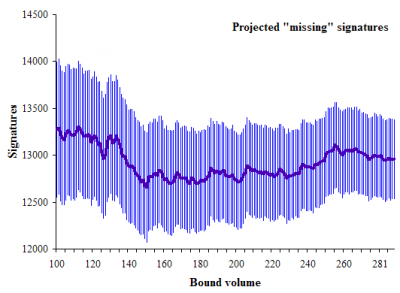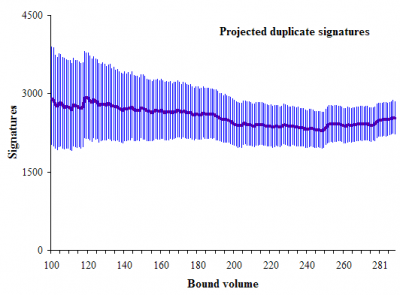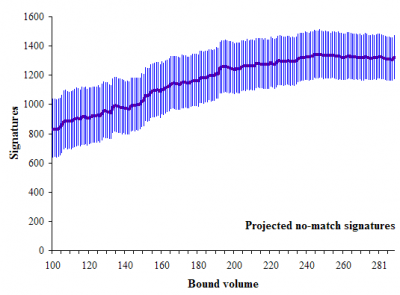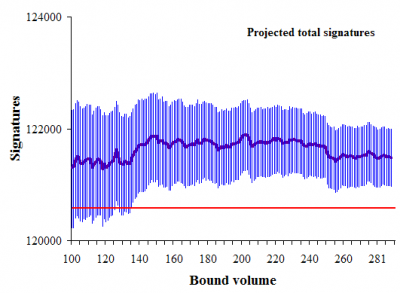Today’s release of R-71 data has the process nearly half-complete. Now 65,531, (47.6%) signatures have been examined in completed volumes. There have been 7,201 invalid signatures found, for an uncorrected rejection rate of 10.99%.
The invalid signatures include 6,165 that were not found in the voting rolls, 470 duplicates, and 566 that did not match the signature on file. There are also 24 pending signatures that I’ve not counted either way.
The 470 duplicates suggest that the overall rate of duplicate signatures for the petition will be about 1.84%. This is slightly higher than what we saw last week, from Tuesday through Friday, 1.62%, 1.74%, 1.73%, and 1.69% respectively.
Using the V2 estimator, the number of valid signatures is expected to be 121,475 exceeding by 898 the 120,577 needed to qualify for the ballot. The overall (i.e. duplicate-corrected) rejection rate is about 11.78%. (Last week we saw 11.61%, 11.53%, 11.54%, 11,65%.)
A Monte Carlo analysis of 100,000 simulated petitions gives this distribution of projected valid signatures for the petition:
In only 34 of the 100,000 simulations did the measure fail to qualify for the ballot (those red bars on the left). The median number of signatures was 121,478 with a 95% confidence interval between 120,951 and 122,003.
As we saw last week…the measure has almost no chance of being rejected.
After the fold, I provide a rather dry analysis by small batches of signature pages for the R-71 obsessives and stats wonks….
I explained the methods in this post last week. This time I will consider the bounded volumes from 100 to 289. Volume 289 is the most recent volume completed (a couple of incomplete volumes are excluded).
This graph shows the trend in the numbers of projected signatures not found on the voter rolls:
The numbers bounce around, well within the limits of the sampling error. The final number of “missing” signatures is projected to be about 12,960 ± 430.
Here are the projected final number of duplicate signatures:
Here we see the last 200 or so volumes are pretty stable with respect to duplicates. The final number of duplicate signatures is projected to be 2,532 ± 325.
The mismatched signature projections shows a slight increasing trend that has stabilized for the last seventy volumes:
The final projected number of mismatched signatures is 1,324 ± 150
The overall trend in projected valid signatures shows remarkable stability, particularly over the last 150 or so volumes. The red line is the number of signatures needed to qualify for the fall ballot.
The projection for total valid signature is 121,475 ± 525. The 95% confidence interval is stably above the minimum number of signatures to qualify for the ballot.
The conclusion, over the past week, the volume-level data show almost no signs of systematic error or any random error outside that explained by sampling alone. The trends are stable and on-track for qualifying for the ballot with about 900 signatures in excess of the minimum required.






go get a life
What I want to know is: how come the wingnuts aren’t directing their “town-hall outrage” at the 7,201 fraudulent signatures found so far in the petition campaign? Isn’t this evidence that the petition supporters are willing to go to any lengths, to violate any law, in order to get their measures on the ballot? Shouldn’t we track down every one of them and prosecute them for voter fraud? Shouldn’t this many fraudulent signatures on the petition be grounds for a “do-over”, requiring them to go out and start the process all over again?
Oh, I forgot. They are Republicans. As Tim Eyman said, “there’s no evidence of voter fraud in initiative campaigns”. Those arguments only apply when Republicans are directing them at Democrates, as they did in the 2004 gubenatorial campaign. Republicans get a permanant pass, apparantly.
manoftruth @ 1,
Sorry ’bout that, Squirt.
We can’t dumb everything down for you retarded fascists.